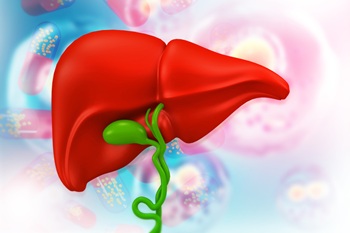DAPAGLIFLOZIN EVALUATED FOR METABOLIC DYSFUNCTION-ASSOCIATED STEATOHEPATITIS IN SMALL STUDY
Dapagliflozin improved MASH in overweight adults with and without diabetes
Straight Healthcare
July 2025
July 2025

Metabolic dysfunction–associated steatohepatitis (MASH), formerly known as nonalcoholic steatohepatitis, is a chronic liver disease strongly associated with obesity and diabetes. Dapagliflozin (Farxiga), an SGLT2 inhibitor approved to treat type 2 diabetes, has been associated with modest weight loss in clinical trials. A small study (N=154) conducted in China evaluated the effects of dapagliflozin on MASH in Chinese adults with or without type 2 diabetes who had biopsy-diagnosed MASH (average BMI 29.2 | type 2 diabetes - 45%). Subjects were randomized to dapagliflozin 10 mg once daily or placebo for 48 weeks. At the end of the trial, the primary outcome, MASH improvement without worsening of liver fibrosis, occurred in 53% of dapagliflozin-treated patients and 30% of placebo-treated patients (p=0.006). Fibrosis improvement without worsening MASH was seen in 45% and 20%, respectively (p=0.001). Over the course of the trial, the dapagliflozin group lost an average of 9.4 lbs, while the placebo group lost 1.7 lbs.
In the small study above, dapagliflozin improved MASH in Chinese people with and without diabetes. An exploratory mediation analysis of the results found that weight loss largely accounted for the higher proportion of MASH improvement and MASH resolution in the dapagliflozin group. However, fibrosis improvement without worsening of MASH was found to be independent of weight loss. Proposed mechanisms by which dapagliflozin may improve MASH independent of weight loss include: (1) modulation of energy homeostasis and improvement of insulin resistance, (2) anti-inflammatory, anti-oxidant, and anti-fibrotic effects, (3) systemic metabolic reprogramming and negative energy balance, and (4) promotion of ketone body synthesis.
Weight loss in the dapagliflozin group was much greater in this trial than what has been observed in diabetes and heart failure trials. Reasons for this are unclear. Larger studies in more diverse populations are needed to further evaluate the effects of SGLT2 inhibitors on MASH.
In the small study above, dapagliflozin improved MASH in Chinese people with and without diabetes. An exploratory mediation analysis of the results found that weight loss largely accounted for the higher proportion of MASH improvement and MASH resolution in the dapagliflozin group. However, fibrosis improvement without worsening of MASH was found to be independent of weight loss. Proposed mechanisms by which dapagliflozin may improve MASH independent of weight loss include: (1) modulation of energy homeostasis and improvement of insulin resistance, (2) anti-inflammatory, anti-oxidant, and anti-fibrotic effects, (3) systemic metabolic reprogramming and negative energy balance, and (4) promotion of ketone body synthesis.
Weight loss in the dapagliflozin group was much greater in this trial than what has been observed in diabetes and heart failure trials. Reasons for this are unclear. Larger studies in more diverse populations are needed to further evaluate the effects of SGLT2 inhibitors on MASH.
